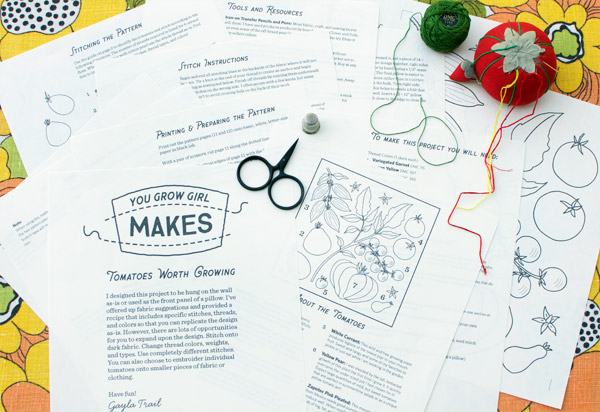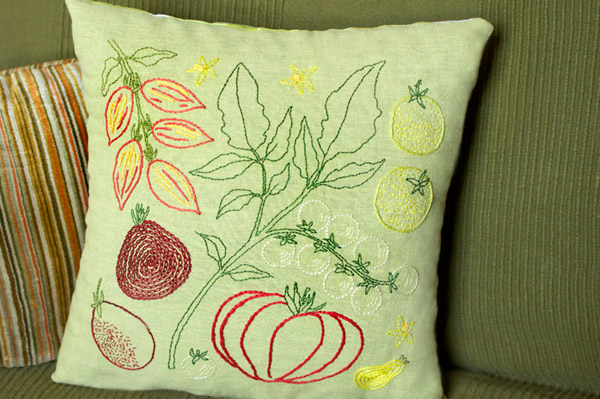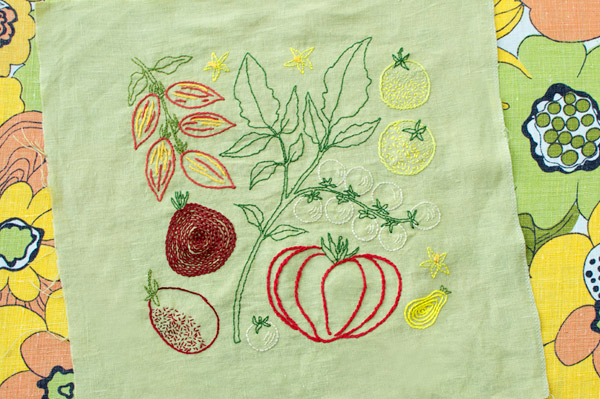
Introducing our newest collaboration, You Grow Girl Makes and our first project in the series, Tomatoes Worth Growing, a 12″ x 12″ embroidered pillow (or wall hanging) dedicated to some of my favourite heirloom tomatoes.
In the off-season, when the garden is put to bed and I am resigned to longer hours spent indoors, I stitch things. I particularly prefer to work with my hands. There is something about the beautiful imperfection of a mark made on fabric with needle and thread. I’m not gonna lie, a certain amount of this preference has to do with my own laziness and the fact that I can do it on the sofa, preferably while watching a movie or a British crime drama. I stitch because it functions as an interesting counterpoint to writing and I also do it to unwind.
Over the years I’ve dabbled with simple stitched projects in my books and here on the website. About a year and a half ago I had the notion to do a big project inspired by the mostly 70s era educational posters that I have hanging all around my house. I love the idea of making projects that are creative, but also serve a practical function to teach about plants. The prediction of a poor tomato season (a hint of nostalgia at work?) seemed to act as a push to move the first project forward and here we are!
This is only the first. We’re already at work on more that we will roll out with the unfolding seasons. I wanted the first project to be a big one, but future sizes will vary. Some will be smaller and easier to stitch and others will be more difficult or time-consumming. Package prices will also vary, depending on length and complexity. This first one is straight-ahead embroidery, but in the future I plan to vary the stitching types, in accordance with my own practice which uses a wide range of threads, fabric types, and stitching styles.

This 12-Page Printable PDF Includes:
- A complete list of materials needed to stitch this project, as well as a color key and suggested options.
- 11″ x 11″ pattern (2 pages tiled. Includes instruction).
- Transfer instructions (5 different methods).
- Stitching lessons and diagrams (4 different stitches)
- A detailed stitch and color guide that you can follow.
- Additional tools, tips, instruction, and resources to help you get started.
- Plus: A write-up of the 7 tomato varieties featured.

About This Project
This first pattern is an ode to tomatoes (my favourite plant to grow). I wanted it to be a large image that could be hung on the wall or sewn up to make a pillow. I chose 7 of my favourite tomatoes, choosing them for their varied shapes, sizes, and colours (they taste great, too!), and Davin set to work drawing up the design. With this first pattern we opted to find a middle ground between beginner and intermediate stitchers. If you are a novice, I suggest practicing on individual tomatoes. You can choose to transfer parts of the pattern to smaller pieces of fabric, tea towels, pillow cases, hankies, skirts and other articles of clothing… whatever you choose. I’ve included 5 different transfer methods that I regularly use, including information on the pluses and drawbacks of each. I limited the stitch types to 4 for this pattern. However, advanced stitchers may want to sub in a few of their own favourites for wider variety. You will find stitching the leaf outline is satisfactorily challenging, especially around the sepals (leafy part at the top of each fruit).
I used DMC brand threads for standardization since I wanted you to have the option to follow a specific stitching recipe or go out on your own using your own threads, fabrics, and stitches. Do not feel obligated to purchase threads from this specific brand. A quick search will show that there are charts online that will convert DMC colours to other brands such as Anchor. We were careful to limit the number of colours so that you do not have to spend loads of cash on new skeins, but I also added optional colours should you choose to increase the palette.
Upon payment you will automatically be sent an email with a download link for the PDF file, which includes a 12-page instruction booklet and pattern. This PDf file may be viewed and/or printed from your computer using Adobe Acrobat Reader, which you can download for free here. You may also view the file on an iPad, Nook, Sony Reader, or KOBO.
Please let me know if you have any questions. I’d also appreciate any questions or comments from those of you who purchase it. Send me a photo of your finished project!
That looks great! I especially love the tomato leaf shape. Might just tempt me to pick up a new winter hobby.
Davin draws great tomato leaves. He drew my tattoo… it’s a bit more detailed than stitching can be… but same basic idea.
I am purchasing momentarily. I just bought an old Stokes seed bag at a flea market this weekend for $1.50. This will look nice, stitched on the other side and turned into a pillow. I may save this project for the wintery months like you mentioned :)
I can picture all kinds of patterns for this series….peppers, herbs, etc. !!! Keep up the good work.
Oh that sounds great! We do plan to do more produce, but there are other ideas as well that I think will surprise you… hopefully in a good way!
Fabulous idea !!
I know many people who obsess on their gardens in warm months and obsess on fabric arts in the cold months.
Perfect marriage of two themes.
You are a genius, and I hope you are amply rewarded through this concept.
I am an absolute beginner. Should I wait for an easier pattern or do you think I could muddle through this? It looks lovely!
I am a beginner too. I sew very simple things with a machine. Aprons and curtains and such but not hand stiching like this. It’s beautiful, I love it and the ideas are awesome. Should we wait for an easier to start or just jump in and practice stiching tomatoes on everything?
Hi Evangeline and Shirley,
My suggestion to beginners is to use portions of the pattern first as practice. So for example, isolate one or two of the tomatoes from the overall pattern onto a smaller piece of fabric and try that first. The largest tomato would be perfect for this because there are few tight corners. Even the leafy parts are much larger. You can also try different stitches rather than the one suggested. I give instruction for 4 stitches. All are simple, but I find that Outline Stitch (the one used on the largest tomato) can be hard to conceptualize as a beginner. For that reason I would start with Back Stitch (also in the instructions) because it is most like everyday hand sewing. Once you’ve had a little practice to ease your mind, you can switch to working on the whole piece.
As a beginner, I found it was important to start with a pattern that I liked rather than sticking to those made just for beginners because if the pattern didn’t interest me I got bored and dropped it.
As a way of encouragement, I want to say that embroidery is a lot more forgiving than you’d think. I really started to enjoy and eventually become addicted to it when I loosened up and stopped worrying about whether my stitches were perfect and evenly sized. In that way I find it a lot more satisfying than machine sewing because it’s so open-ended and creative.. and also slower. I also like that you can take it up, drop it, and go back to it whenever you want. In that way it is much less demanding than gardening! Ha!
Okay, I am going to try it!
Great! Make sure to start with the fruit part of the tomato first. You’ll find the larger curves are easier to work than the tighter corners on the foliage. You might also try working it in straight stitch the first time since this is exactly the same as regular hand sewing. That may help get you comfortable working with the thicker thread and needle.
I love this idea and I’m so glad you’re doing it! I love embroidery and it’s hard to find patterns that are up my alley (and not super cutesy). Thanks to you both.
Love this! Just bought the pattern and can’t wait to try it, in between ‘putting up’ all the tomatoes in my garden from this year. Also looking forward to what you offer next!